Boundaries

The Municipal Borough of Ealing wards of: Greenford North, Greenford South, Hanwell North, Hanwell South, and Northolt.
| Ealing West | |
|---|---|
| Former Borough constituency for the House of Commons | |
| Major settlements | Hanwell, Greenford, and Northolt |
| 1945–1950 | |
| Number of members | one |
| Replaced by | Ealing North (bulk) Ealing South (part) (newly created seats) Southall as to Hanwell |
| Created from | Harrow (bulk from) Uxbridge (Northolt from) |
Ealing West was a constituency, 1945 to 1950 containing parts of the Municipal Borough of Ealing in Middlesex, in west north-west London. It returned one member (MP) to the House of Commons of the UK Parliament using the first past the post system.
The constituency was created for the 1945 general election and abolished for the 1950 general election. From that date, the Municipal Borough of Ealing was represented by the new Ealing North and Ealing South; and by the Southall constituency which included two wards of the borough of Ealing until that constituency's abolition in February 1974.

The Municipal Borough of Ealing wards of: Greenford North, Greenford South, Hanwell North, Hanwell South, and Northolt.
| Election | Member | Party | |
|---|---|---|---|
| 1945 | James Hudson | Labour | |
| 1950 | constituency abolished: see Ealing North and Ealing South | ||
| Party | Candidate | Votes | % | ±% | |
|---|---|---|---|---|---|
| Labour | James Hudson | 29,115 | 60.3 | ||
| Conservative | Bernard Sunley | 12,880 | 26.7 | ||
| Liberal | Herbert Mostyn Lewis | 6,258 | 13.0 | ||
| Majority | 16,235 | 33.6 | |||
| Turnout | 48,253 | 74.4 | |||
| Labour win (new seat) | |||||

Greenford is a suburb in the London Borough of Ealing in west London, England, lying 11 miles (18 km) west from Charing Cross. It has a population of 46,787 inhabitants, or 62,126 with the inclusion of Perivale.
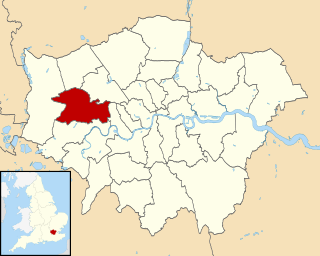
The London Borough of Ealing is a London borough in West London. It comprises seven major towns: Acton (W3), Ealing, Greenford (UB6), Hanwell (W7), Northolt (UB5), Perivale (UB6) and Southall. With a population of 341,806 inhabitants, it is the fourth most populous London borough.

West Ealing is a district in the London Borough of Ealing, in West London. The district is about three-quarters of a mile (1.2 km) west of Ealing Broadway. Although there is a long history of settlement in the area, West Ealing in its present form is less than one hundred years old. West Ealing falls under the postcode district W13 and neighbours Hanwell, Ealing, Perivale and Northfields
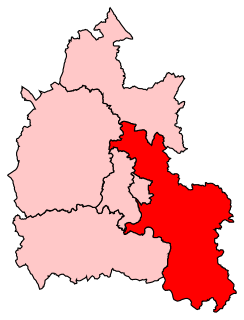
Henley is a constituency in Oxfordshire represented in the House of Commons of the UK Parliament since 2008 by John Howell, a member of the Conservative Party. He was elected in a by-election following the resignation of Boris Johnson, who had taken office as Mayor of London. The constituency was established for the 1885 general election.
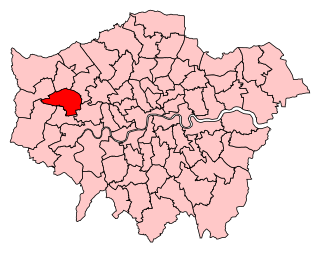
Ealing North is a constituency, created in 1950. Since the 2019 general election, it has been represented in the House of Commons of the UK Parliament by James Murray of the Labour Co-operative party.

Ealing, Southall is a constituency created in 1974 and represented in the House of Commons of the UK Parliament since 2007 by Virendra Sharma of the Labour Party.

Fylde is a constituencyin Lancashire which is represented in the House of Commons of the UK Parliament since 2010 by Mark Menzies, a Conservative.
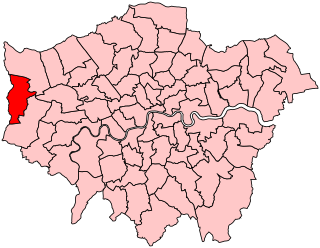
Uxbridge was a seat returning one Member of Parliament (MP) of the House of Commons of the UK Parliament from 1885 to 2010. Its MPs elected were: Conservative Party candidates for 107 years and Labour Party candidates for 18 years. The closing 40 years of the seat's history saw Conservative victory — in 1997 on a very marginal majority in relative terms.

Bradford East is a constituency represented in the House of Commons of the UK Parliament since 2015 by Imran Hussain of the Labour Party.

Acton was a constituency of the House of Commons of the Parliament of the United Kingdom, created for the 1918 general election. It elected one Member of Parliament (MP) by the first-past-the-post system of election.
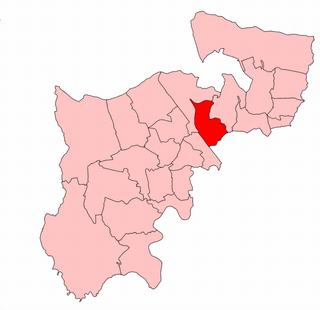
Hendon South was a constituency in the former Municipal Borough of Hendon which returned one Member of Parliament (MP) to the House of Commons of the Parliament of the United Kingdom. It was created for the 1945 general election, when the Hendon seat was split into two, and abolished for the 1997 general election, with Childs Hill, Garden Suburb, and Golders Green wards going to Finchley and Golders Green along with wards from Finchley. Hendon and West Hendon wards were transferred to new constituency: Hendon.
Bradford Central was a parliamentary constituency in the city of Bradford, West Yorkshire, which returned one Member of Parliament (MP) to the House of Commons of the Parliament of the United Kingdom. Elections were held under the first-past-the-post voting system.
Southall was a constituency from 1945 to 1983. It returned one member (MP) to the House of Commons of the UK Parliament. The Labour Party candidate won the seat at each general election and no by-elections took place.
Wandsworth Central was a parliamentary constituency in the Wandsworth district of South London. It returned one Member of Parliament (MP) to the House of Commons of the Parliament of the United Kingdom, elected by the first-past-the-post voting system.

Ealing was a parliamentary constituency centred on the Ealing district of west London. It returned one Member of Parliament (MP) to the House of Commons of the UK Parliament, 1885–1945. In common with metropolitan areas the seat saw major population increase. Until 1918 it included Chiswick, Acton within the County of London, and part of Hanwell in the rump of dwindling Middlesex.
Ealing East was one of two and a minority of a third constituency covering the Municipal Borough of Ealing in Middlesex, 1945 – 1950. It included the town centre and in terms of local government content became, after its abolition, part of west London in 1965 at which time the borough expanded further to the east and west.
Ealing South was a constituency covering the same part of the Municipal Borough of Ealing in Middlesex as its short-lived forerunner Ealing East. It returned one member (MP) to the House of Commons of the UK Parliament. It was won by two Conservatives consecutively with majorities ranging from 13.6% to 30.5%, was first contested in the general election in 1950 and was replaced before that of February 1974.